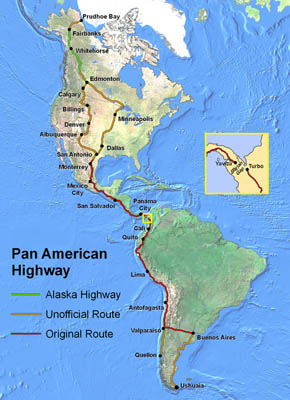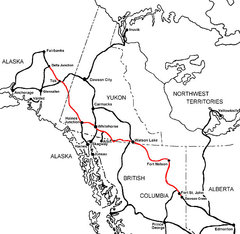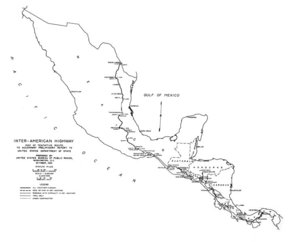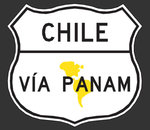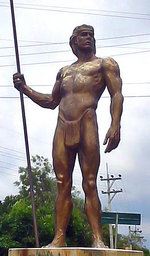Panamerican Highway
The Pan-American Highway (French: Route panaméricaine, Spanish: Carretera Panamericana) is a network of roads nearly 25,000 kilometres (29,800 miles) in total length. Except for an 87 kilometre (54 mi) rainforest break, called the Darién Gap, the road links the mainland nations of the Americas in a connected highway system. According to Guinness World Records, the Pan-American Highway is the world's longest "motorable road". However, because of the Darién Gap, it is not possible to cross between South America and Central America by traditional motor vehicle.
The Pan-American Highway system is mostly complete and extends from Prudhoe Bay, Alaska, in North America to the lower reaches of South America. Several highway termini are claimed to exist, including the cities of Puerto Montt and Quellón in Chile and Ushuaia in Argentina. No comprehensive route is officially defined in Canada and the United States, though several highways there are called "Pan-American".
The Pan-American Highway passes through many diverse climates and ecological types, from dense jungles to cold mountain passes. Since the highway passes through many countries, it is far from uniform. Some stretches of the highway are passable only during the dry season, and in many regions driving is occasionally hazardous.
Famous sections of the Pan-American Highway include the Alaska Highway and the Inter-American Highway (the section between the United States and the Panama Canal). Both of these sections were built during World War II as a means of supply of remote areas without danger of attack by U-boats.
Jake Silverstein, writing in 2006, described the Pan-American Highway as "a system so vast, so incomplete, and so incomprehensible it is not so much a road as it is the idea of Pan-Americanism itself…"
Pan-American Highway system overview
The Pan-American Highway travels through 14 countries:
- Canada (unofficially)
- United States (unofficially)
- Mexico
- Guatemala
- El Salvador
- Honduras
- Nicaragua
- Costa Rica
- Panama
- Colombia
- Ecuador
- Peru
- Chile
- Argentina
Important spurs also lead into Bolivia, Brazil, Paraguay, Uruguay and Venezuela.
For tourism purposes, the Pan-American Highway north of Central America is sometimes assumed to use the Alaska Highway and then run down the west coast of Canada and the United States, running east from San Diego, California and picking up the branch to Nogales, Arizona.Template:Fact
Darién Gap
The notable stretch that keeps the highway from being completely connected is a section of land located in the Darién Province in Panama and the Colombian border called the Darién Gap, which is an 87 km (54 mile) stretch of rainforest. The gap has been crossed by adventurers on bicycle, motorbike, all-terrain vehicle, and foot, dealing with jungle, swamp, insects, and other hazards.
There are many people, groups, indigenous populations, and governments that are opposed to completing the Darién portion of the highway, with reasons as varied as the desire to protect the rain forest, containing the spread of tropical diseases, protecting the livelihood of indigenous peoples in the area, preventing drug trafficking and its associated violence from emanating out of Colombia, and preventing foot and mouth disease from entering North America. Experience with the extension as far as Yaviza included severe deforestation alongside the highway route within a decade.
One option proposed, in a study by Bio-Pacifico, is a short ferry link from Colombia to a new ferry port in Panama, with an extension of the existing Panama highway that would complete the highway without violating these environmental concerns. The ferry would cross the Gulf of Urabá from Turbo, Colombia, to a new Panamanian port (possibly Carreto) connected to a Caribbean coast extension of the highway. Efficient routing would probably dictate that the existing route to Yaviza be relegated to secondary road status.
Development and completion
The concept of a route from one tip of the Americas to the other was originally proposed at the First Pan-American Conference in 1889 as a railroad; however, nothing ever came of this proposal. The idea of the Pan-American Highway emerged at the Fifth International Conference of American States in 1923, where it was originally conceived as a single route. The first Pan-American highway conference convened October 5, 1925 in Buenos Aires. Mexico was the first Latin American country to complete its portion of the highway, in 1950.
Northern section of the Pan-American Highway
No road in the U.S. or Canada has been officially designated as the Pan-American Highway, and thus the primary road officially starts at the U.S.-Mexico border. The original route began at the border at Nuevo Laredo, Tamaulipas (opposite Laredo, Texas) and went south through Mexico City. Later branches were built to the border at Nogales, Sonora (Nogales, Arizona), Ciudad Juárez, Chihuahua (El Paso, Texas), Piedras Negras, Coahuila (Eagle Pass, Texas), Reynosa, Tamaulipas (Pharr, Texas), and Matamoros, Tamaulipas (Brownsville, Texas).
On the other hand, several roads in the U.S. were locally named after the Pan-American Highway. When the section of Interstate 35 in San Antonio, Texas was built, it was named the Pan Am Expressway, as an extension of the original route from Laredo. Interstate 25 in Albuquerque, New Mexico has been named the Pan-American Freeway, as an extension of the route to El Paso. U.S. Route 85, which goes north from El Paso, is designated the CanAm Highway, which continues into Canada in the province of Saskatchewan, before terminating at La Ronge. The CANAMEX Corridor is also similarly designated throughout the western United States, and continuing into the Canadian province of Alberta.
The original route to Laredo travels up Mexican Federal Highway 85 from Mexico City. The various spurs follow:
- Nogales spur - Mexican Federal Highway 15 from Mexico City
- El Paso spur - Mexican Federal Highway 45 from Mexico City
- Eagle Pass spur - unknown, possibly Mexican Federal Highway 57 from Mexico City
- Pharr spur - Mexican Federal Highway 40 from Monterrey
- Brownsville spur - Mexican Federal Highway 101 from Ciudad Victoria
From Mexico City to the border with Guatemala, the Highway follows Mexican Federal Highway 190. Through the Central American countries, it follows Central American Highway 1, ending at Yaviza, Panama at the edge of the Darién Gap. The road had formerly ended at Cañita, Panama, 110 miles (178 km) north of its current end. United States government funding was particularly significant to complete a high-level bridge over the Panama Canal, during the years when the canal was administered by the United States.
Southern section of the Pan-American Highway
The southern part of the highway begins in northwestern Colombia, from where it follows Colombia Highway 52 to Medellín. At Medellín, Colombia Highway 54 leads to Bogotá, but Colombia Highway 11 turns south for a more direct route. Colombia Highway 72 is routed southwest from Bogotá to join Highway 11 at Murillo. Highway 11 continues all the way to the border with Ecuador.
Ecuador Highway 35 runs the whole length of that country. Peru Highway 1 carries the Pan-American Highway all the way through Peru to the border with Chile.
In Chile, the highway follows Chile Highway 5 south to a point north of Santiago, where the highway splits into two parts, one of which goes through Chilean territory to Quellón on Chiloé Island, after which it continues as the Carretera Austral. The other part goes east along Chile Highway 60, which becomes Argentina National Route 7 at the Argentinian border and continues to Buenos Aires, the end of the main highway. The highway network also continues south of Buenos Aires along Argentina National Route 3 towards the city of Ushuaia and Cape Horn.
One branch, known as the Simón Bolívar Highway, runs from Bogotá (Colombia) to Guiria (Venezuela). It begins by using Colombia Highway 71 all the way to the border with Venezuela. From there it uses Venezuela Highway 1 to Caracas and Venezuela Highway 9 to its end at Guiria.
A continuation of the Pan-American Highway to the Brazilian cities of São Paulo and Rio de Janeiro uses a ferry from Buenos Aires to Colonia in Uruguay and Uruguay Highway 1 to Montevideo. Uruguay Highway 9 and Brazil Highway 471 route to near Pelotas, from where Brazil Highway 116 leads to Brazilian main cities.
Another branch, from Buenos Aires to Asunción in Paraguay, heads out of Buenos Aires on Argentina National Route 9. It switches to Argentina National Route 11 at Rosario, which crosses the border with Paraguay right at Asunción. Other branches probably exist across the center of South America.
The highway does not have official segments to Belize, Guyana, Suriname and French Guiana, nor to the assorted islands in the Caribbean region. However, highways from Venezuela link to Brazilian Trans-Amazonian highway that provide a southwest entrance to Guyana, route to the coast, and follow a coastal route through Suriname to French Guiana. Belize was supposedly included in the route at one time, as they switched which side of the road they drive on. As British Honduras, they were the only Central American country to drive on the left side of the road.
In art and culture
The Pan-American highway is the subject of a 2006 conceptual art piece, The School of Panamerican Unrest, where Mexican-born artist Pablo Helguera is attempting to drive a portable schoolhouse for the length of the entire route.
The travel writer Tim Cahill wrote a book, Road Fever, about his record-setting 24-day drive from Ushuaia in the Argentine province of Tierra del Fuego to Prudhoe Bay in the U.S. state of Alaska with professional long-distance driver Garry Sowerby, much of their route following the Pan-American Highway.
See also
Sources
- Plan Federal Highway System, New York Times May 15, 1932 page XX7
- Reported from the Motor World, New York Times January 26, 1936 page XX6
- Hemisphere Road is Nearer Reality, New York Times January 7, 1953 page 58
- 1997-98 AAA Caribbean, Central America and South America map
References
- http://www.panamericana-movie.com - The Blog to the Production of the first feature Film about the Original Route of the Pan-American Highway. 2010 in Cinemas!
